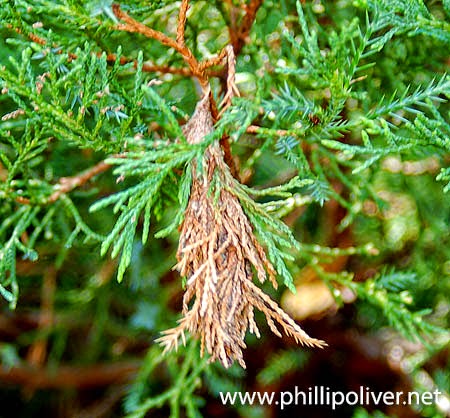The name sounds disgusting, doesn't it? Actually, they don't look that menacing when you see them on the plant. In fact, they can be easily mistaken for a cone or part of a plant. Don't be misled though - these devious critters are highly destructive and can kill a plant before you realize what has happened. There are different types of bagworms but the evergreen bagworm is the one addressed here. It is prevalent in the eastern U.S. and attacks evergreens such as arborvitae, red cedar, junipers, etc. Even decidious trees are vulnerable, however, damage is minimal to them because they shed their leaves.
This is what they can do -
Bagworms are actually the larvae of a moth. They are 1-2 inches long and create a cocoon made up of silk and bits of dead foliage and twigs. During the summer months, the larvae consumes plant foliage and retreats into the cocoon when disturbed. The larvae carries the cocoon (or bag) around and it larger and larger as they eat more and more. By late August, feeding stops and a pupa forms inside the bag. A moth emerges from the pupa. The female moths stays inside the bag. The male flies to bags containing the females and they mate. The female then lays 300-1000 eggs in the bag and then she promptly dies. The eggs hatch the following May and early June and the whole vicious cycle starts over again.
You can control them by spraying an insecticide but this has to be done in May and early June to be effective. The larvae are so small, most gardeners don't see them until the bags start to form. Feeding slows in August so spraying doesn't do any good after that.
Hand picking them is another alternative. Of course, if it is a large tree, that option might be out of the question.
A few years ago, I noticed bagworms on our Colorado Blue Spruce. I picked them off and never saw them again. This year I've noticed them on the junipers out next to the street. This morning I spent an hour picking them off and tossing them into the road where I envision car tires squishing the disgusting buggers to kingdom come.
Text and photos by Phillip Oliver, Dirt Therapy


These rascals ate the top out of a blue spruce one year. I pull and plucked and cursed until I got them all. Luckily the spruce rejuvenated itself. I threw a few into the trash can in the kitchen one time and when I returned to the kitchen they were creeping out over the edge. You gotta be vigilant.
ReplyDeleteWe've delt with bag worms. They are a menece. The "mother ship" as my husband likes to call them tucks herself deeper into the tree in the fall, lays the eggs and dies. In the spring, the baby bag worms come out to start to feed. Look for the "mother ships" at the end of summer and if you get those, you can greatly reduce the population for next year. We never sprayed. We haven't seen any for about five years. We battled them three to four years getting less each year. It helps that the bushes at a rental property across the street have been removed. They were a bag worm nursery. It's theraputic to squish 'em.
ReplyDeletewow, I've never seen them and from this I hope I never do!
ReplyDeleteI despise these things! I took out a tree this spring riddled with them because I was tired of messing with it. There are still bagworms hanging around the house but there aren't many plants they like to attack nearby.
ReplyDeleteThey sound disgusting and I'm glad to know what to be looking for. I hope you're able to save your plants and I hope I don't see any around here.
ReplyDeleteoh wow, what a pest! I've never seen that before!
ReplyDeleteSuch a satisfying "pop" between forefinger and thumb.
ReplyDeleteEewww, nasty little things. I'll be sure to have a good look at my spruce and other evergreens when I get home.
ReplyDeleteMarnie
'Bagworms' sounds horrible. O_O I don't even like saying it out loud. I don't want lunch now.
ReplyDelete:P
Your photography makes them look good. :)
ReplyDeleteWow. I'm glad I've never encountered them before! Good luck getting rid of them.
ReplyDeleteI hate them.~~Dee
ReplyDeleteI don't have any conifers or such in my yard, but I did at one place I lived. I hate these things! I always pulled them off and threw them in the trash can.
ReplyDelete~Randy
We have had an over abundance of plant eating critters here this year. I hope you got them all!
ReplyDeleteBattling these also on some conifers. One actually ended up on my rose bush and I got a close up look and wow, they are really ugly when they poke their heads out. Yuck.
ReplyDeleteI've heard of bagworms but have never seen them. Now, every time I see some dead spots on an evergreen, I'm going to do a double take!
ReplyDeleteJust pulled one off a shrub~They are destructive critters~gail
ReplyDelete